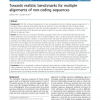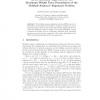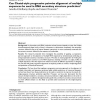97 search results - page 3 / 20 » An evolutionary progressive multiple sequence alignment |
BMCBI
2010
13 years 5 months ago
2010
Background: With the continued development of new computational tools for multiple sequence alignment, it is necessary today to develop benchmarks that aid the selection of the mo...
PPSN
2004
Springer
13 years 10 months ago
2004
Springer
Abstract. The multiple sequence alignment problem (MSA) can be reformulated as the problem of finding a maximum weight trace in an alignment graph, which is derived from all pairw...
GECCO
2003
Springer
13 years 10 months ago
2003
Springer
This article presents a model for DNA sequence alignment. In our model, a finite state automaton writes two-dimensional maps of nucleotide sequences. An evolutionary method for se...
BMCBI
2007
13 years 5 months ago
2007
Background: In ribonucleic acid (RNA) molecules whose function depends on their final, folded three-dimensional shape (such as those in ribosomes or spliceosome complexes), the se...
GECCO
2005
Springer
13 years 11 months ago
2005
Springer
The problem of multiple sequence alignment is important for bioinformatics. This problem is widely studied and a popular tool to solve this problem is Clustal X. This work introdu...



